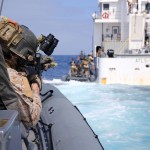Tasking
Marine Corps Special Operations Command (MARSOC) train, organize, equip and deploy task organized, scalable and responsive Marine Corps special operations forces worldwide in support of combatant commanders and other agencies.
History & Heritage
 Its creation was announced on 23 November 2005 by US Defense Secretary Donald Rumsfeld, following a meeting between him, the USSOCOM commander General Bryan D. Brown, and the Marine Corps Commandant General Michael Hagee on 28 October 2005. MARSOC was officially activated on 24 February 2006 with ceremonies at Camp Lejeune, North Carolina.
Its creation was announced on 23 November 2005 by US Defense Secretary Donald Rumsfeld, following a meeting between him, the USSOCOM commander General Bryan D. Brown, and the Marine Corps Commandant General Michael Hagee on 28 October 2005. MARSOC was officially activated on 24 February 2006 with ceremonies at Camp Lejeune, North Carolina.
The potential participation of the Marine Corps in SOCOM has been controversial since SOCOM was formed in 1986. At the time, Marine Corps leaders felt that their Force Reconnaissance units were best kept in the Marine Corps’ MAGTF command structure, and that the detachment of an “elite” Marine Special Operations unit from the Marine Corps would be to the detriment of the Marine Corps as a whole. A re-evaluation following the 11 September attacks and the War on Terrorism, along with new policy established by Secretary Rumsfeld and then-Commandant Gen. James L. Jones at The Pentagon, caused the Marine Corps to work towards integration with SOCOM.
 The establishment of MARSOC represented the most significant step towards that goal, and followed the establishment of MCSOCOM Detachment One (DET1), a small Marine Corps detachment formed as a pilot program to test Marine Corps integration into SOCOM. It was made up of mostly Force Recon Marines from 1st and 2nd Force Reconnaissance Companies along with other hand picked support men and served with Navy SEALs under Naval Special Warfare Group One. Detachment 1 conducted a multitude of special operations in Iraq alongside their Special Operations brothers of the sister services. SOCOM conducted a study of the unit’s deployment, which clearly indicated success and strong performance. Detachment 1 was disbanded in 2006 soon after the creation of MARSOC.
The establishment of MARSOC represented the most significant step towards that goal, and followed the establishment of MCSOCOM Detachment One (DET1), a small Marine Corps detachment formed as a pilot program to test Marine Corps integration into SOCOM. It was made up of mostly Force Recon Marines from 1st and 2nd Force Reconnaissance Companies along with other hand picked support men and served with Navy SEALs under Naval Special Warfare Group One. Detachment 1 conducted a multitude of special operations in Iraq alongside their Special Operations brothers of the sister services. SOCOM conducted a study of the unit’s deployment, which clearly indicated success and strong performance. Detachment 1 was disbanded in 2006 soon after the creation of MARSOC.
Initial milestones established by USSOCOM
- 24 Feb 2006 – MARSOC HQ activated at Camp Lejeune.
- 17 July 2006 – MARSOC designated SOF by SecDef and assigned to SOCOM.
- Full Operational Capability: 8 October 2006
- The first Marine Special Operations Individual Training Course began at Camp Lejeune on 6 October 2008.
Mission Set(s)
- Stability Operations (SO)
- Foreign Internal Defense (FID)
- Counterinsurgency (COIN)/Support to Unconventional Warfare
- Direct Action (DA)
- Special Reconnaissance (SR)
- Security Force Assistance (SFA)
- Counterterrorism (CT)
- Support to Major Combat Operations (MCO)
Screening & Selection

Selection of the right personnel begins with a rigorous screening process designed to identify the right Marines for the right billet within MARSOC. Operational billets
are open only to males. Only those Marines wanting to serve as special operators, as opposed to support, must attend Assessment and Selection (A&S); however, all Marines are screened to ensure that the Marines joining MARSOC meet the established prerequisites for duty within the command. Screening takes place in 3 stages: record screening, physical screening, and a psychological and medical evaluation.
The Individual Training Course is a physically and mentally challenging 7-month course designed to produce Critical Skills Operators who can operate across the spectrum of special operations in small teams under spartan conditions. ITC uses a building block approach; the training rigor will systematically increase to mimic the complexity and stresses of combat. During ITC students are under constant observation from the instructors as well as their peers. ITC is broken down into four training phases.
More information on recruiting requirements > http://www.marsoc.marines.mil/Recruiting.aspx
Phase 1

Phase 1 trains and evaluates students in the basic skill sets required of all special operators. Physical fitness, swimming and hand-to-hand combat are stressed in a PT program designed around endurance, functional fitness and amphibious training. This physical training program will continue throughout the course and has been designed to prepare the student for the unique demands of special operations. Field skills including: navigation, patrolling, Survival, Evasion, Resistance, and Escape (SERE), Tactical Combat Casualty Care (TCCC). Mission planning, Fire support training and Communications round out the first phase.
Phase 2
Phase 2 builds upon the foundation of Phase 1, training the student in small boat and scout swimmer operations, crew served weapons, demolitions, photography and information collection and reporting. Students will be evaluated in two Full Mission Profile exercises “Operation Raider Spirit”, a 2 week exercise focused on patrolling and combat operations, and “Operation Stingray Fury” focused on urban and rural reconnaissance
Phase 3
Student will be trained in rifle and pistol combat marksmanship and will then learn the tactics, techniques and procedures needed to serve as a member of a Marine Special Operations Team during assault operations. This Phase culminates in a series of full mission profile precision raids on rural and urban objectives during “Operation Guile Strike”.
Already have an account? Sign In
Two ways to continue to read this article.
Subscribe
$1.99
every 4 weeks
- Unlimited access to all articles
- Support independent journalism
- Ad-free reading experience
Subscribe Now
Recurring Monthly. Cancel Anytime.
Phase 4
In the final phase, students will receive instruction on Irregular Warfare operations. The course culminates with “Operation Derna Bridge”. Derna Bridge will require the student to use all of the skills mastered throughout the course while training, advising and operating with a Partner Nation / Irregular force. Newly graduated Marine special operators will be assigned to one of the three Marine Special Operations Battalions.
Language Training
All Marine special operators are required to undergo continual language training. However, based on ability, certain Marines will be selected for follow-on language training at an Advanced Linguistics Course.
Advanced Training
The training of Marine special operators does not end with ITC. Marines will continue training at their assigned battalion for another 18 months. In addition, the MSOS offers advanced-level courses in a number of subject areas: Special Reconnaissance, Close Quarters Battle, Sniper, Breaching, and weapons employment. Marine special operators also attend U.S. Army Airborne School and the USMC Combatant Diver Course.
Force Structure & Organization
MARSOC comprises roughly 2,500 Marines and sailors, and is currently commanded by Major General Paul E. Lefebvre. MARSOC’s organization was finalized in 2007. The base unit of MARSOC is the fourteen-man Marine Special Operations Team (MSOT). Each 14-man MSOT is organized into three elements: a Headquarters (HQ) and two identical Tactical Elements. The HQ element consists of the Team Leader (Captain), Team Chief (Master Sergeant), Operations Chief (Gunnery Sergeant), and a Communications Chief. Each Tactical Element consists of an Element Leader (Staff Sergeant), three Critical Skills Operators (Sergeant/Corporal), and a Navy Special Amphibious Reconnaissance Corpsman (SARC). MARSOC is based at Camp Lejeune, North Carolina and is split into three subordinate commands.
Personal & Crew Served Weapons
MEU(SOC)
M1911A1
Glock 19
Mossberg 590A1
Benelli M4 Super 90
M26 Modular Accessory Shotgun System
FN SCAR-H
M4A1 Carbine
FN SCAR-L
Heckler & Koch HK416
Close Quarters Battle Receiver
Browning M2 Heavy Barrel
GE M134 Minigun
M240B
M249
Mk 48 Mod 0
FGM-148 Javelin
M136 AT4
M72A2 LAW
Carl Gustav M3
M203 grenade launcher
M79 grenade launcher
Milkor Mark 14
Mk 19 grenade launcher
Mk 47 Mod 0 Grenade Launcher
M39 Enhanced Marksman Rifle
M40A5 Sniper Rifle
Barrett M107
Knight’s Armament SR-25
Mk 12 Mod 0/1 Special Purpose Rifle
M67 hand grenade
AN/M14 incendiary grenade
Insert & Extract Platforms
Asolo hikingboots
Ground Mobility Vehicle (GMV-M)
RG-33
Oshkosh M-ATV
Polaris ATV / Quad bikes
KTM 250 SX‑F
All other ground and air platforms are generic to the U.S. Military
Life on a Team
Read this book for an unfiltered look > Level Zero Heroes
Fallen Team Members
Gunnery Sergeant Robert L. Gilbert II
Staff Sergeant Charles I. Cartwright
Corporal Travis M. Woods
Hospital Corpsman Second Class Charles Luke Milam
Staff Sergeant Edgar A. Heredia
Captain Garrett T. Lawton
Sergeant William J. Woitowicz
Staff Sergeant David P. Day
Sergeant Michael C. Roy
Captain Joshua S. Meadows
Staff Sergeant Christopher J. Antonik
Staff Sergeant Nicholas Sprovtsoff
Sergeant Justin M. Hansen
Staff Sergeant Gregory T. Copes
Hospital Corpsman First Class Darrel L. Enos
Gunnery Sergeant Jonathan W. Gifford
Gunnery Sergeant Daniel J. Price
Staff Sergeant Sky R. Mote
Gunnery Sergeant Ryan Jeschke
Captain Matthew P. Manoukian
Staff Sergeant Dennis E. Kancler
Staff Sergeant Patrick R. Dolphin
Sergeant Christopher M. Wrinkle
Sergeant Michael James Guillory
Staff Sergeant Eric D. Christian
Corporal David M. Sonka
MWD Flex
MWD Tosca
Current list available and maintained at the MARSOC Foundation & LevelZeroHeroes/Fallen
Foundation(s)
MARSOC Foundation > https://www.marsocfoundation.org/
FAQ
The best place to ask general questions is on the command sponsored Facebook page > Facebook/MARSOC or join the SOFREP Team Room and ask a MARSOC Operator
Resources
Official MARSOC Website > http://www.marsoc.marines.mil/
MARSOC by Fred Pushies > http://www.amazon.com/MARSOC/
MARSOC Year in Review 2012-2013 > http://www.defensemedianetwork.com/
Level Zero Heroes by Michael Golembesky > http://www.levelzeroheroes.com/
*NEW* MARSOC Website > http://www.marsoc.com/
Article originally written by Michael Golembesky for SOFREP in 2013.
Support the SOFREP community with a lifetime membership. Sign Up Now













